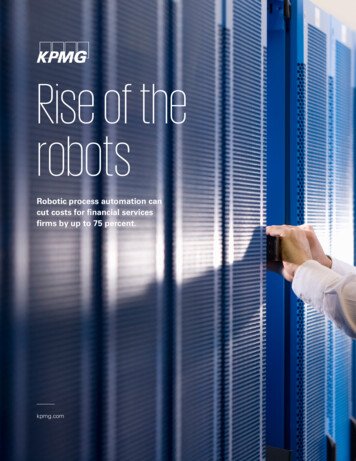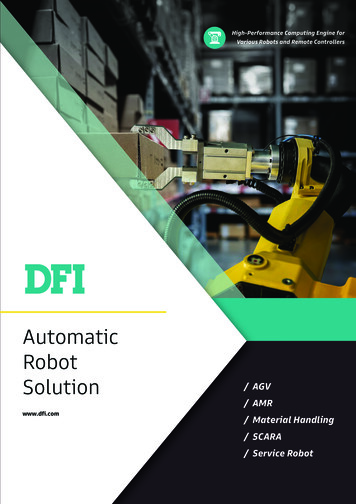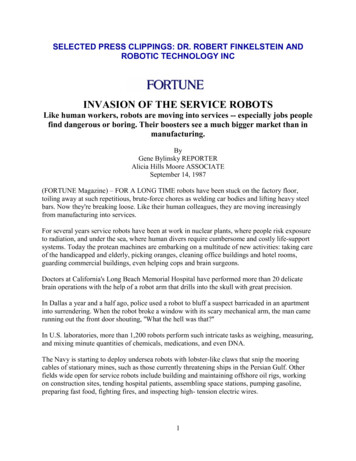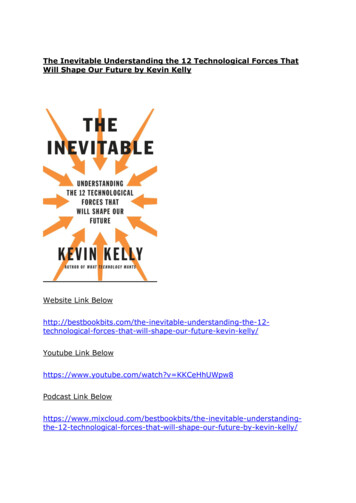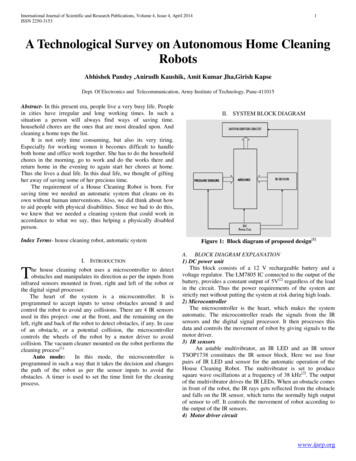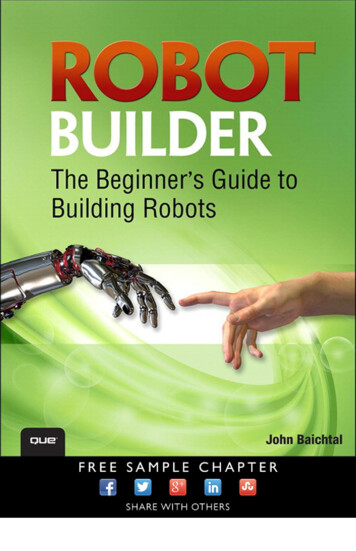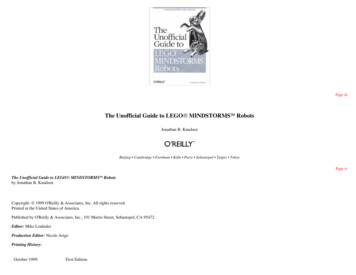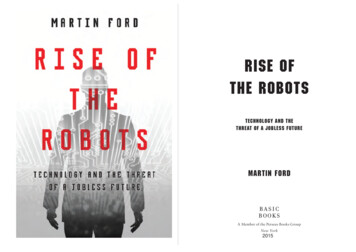
Transcription
Rise ofthe RobotsTechnology and theThreat of a Jobless FutureMARTIN FORDA Member of the Perseus Books GroupNew York2015
CONTENTSINTRODUCTIONIntroductionixChapter 1 The Automation Wave1Chapter 2 Is This Time Different?29Chapter 3 Information Technology:An Unprecedented Force for DisruptionChapter 4 White-Collar Jobs at Risk6383Chapter 5 Transforming Higher Education129Chapter 6 The Health Care Challenge145Chapter 7 Technologies and Industries of the Future175Chapter 8 Consumers, Limits to Growth . . . and Crisis?193Chapter 9 Super-Intelligence and the Singularity229Chapter 10 Toward a New Economic Index317viiSometime during the 1960s, the Nobel laureate economist Milton Friedman was consulting with the government of a developingAsian nation. Friedman was taken to a large-scale public works project, where he was surprised to see large numbers of workers wieldingshovels, but very few bulldozers, tractors, or other heavy earth-movingequipment. When asked about this, the government official in chargeexplained that the project was intended as a “jobs program.” Friedman’s caustic reply has become famous: “So then, why not give theworkers spoons instead of shovels?”Friedman’s remark captures the skepticism—and often outrightderision—expressed by economists confronting fears about the prospect of machines destroying jobs and creating long-term unemployment. Historically, that skepticism appears to be well-founded. In theUnited States, especially during the twentieth century, advancing technology has consistently driven us toward a more prosperous society.There have certainly been hiccups—and indeed major disruptions—along the way. The mechanization of agriculture vaporized millions of jobs and drove crowds of unemployed farmhands into cities in search of factory work. Later, automation and globalizationpushed workers out of the manufacturing sector and into new servicejobs. Short-term unemployment was often a problem during theseix
xIntroductionIntroductionxitransitions, but it never became systemic or permanent. New jobswere created and dispossessed workers found new opportunities.What’s more, those new jobs were often better than earlier counterparts, requiring upgraded skills and offering better wages. At notime was this more true than in the two and a half decades following World War II. This “golden age” of the American economy wascharacterized by a seemingly perfect symbiosis between rapid technological progress and the welfare of the American workforce. As themachines used in production improved, the productivity of the workers operating those machines likewise increased, making them morevaluable and allowing them to demand higher wages. Throughoutthe postwar period, advancing technology deposited money directlyinto the pockets of average workers as their wages rose in tandemwith soaring productivity. Those workers, in turn, went out andspent their ever-increasing incomes, further driving demand for theproducts and services they were producing.As that virtuous feedback loop powered the American economyforward, the profession of economics was enjoying its own goldenage. It was during the same period that towering figures like PaulSamuelson worked to transform economics into a science with astrong mathematical foundation. Economics gradually came to bealmost completely dominated by sophisticated quantitative and statistical techniques, and economists began to build the complex mathematical models that still constitute the field’s intellectual basis. Asthe postwar economists did their work, it would have been naturalfor them to look at the thriving economy around them and assumethat it was normal: that it was the way an economy was supposed towork—and would always work.In his 2005 book Collapse: How Societies Choose to Succeedor Fail, Jared Diamond tells the story of agriculture in Australia. Inthe nineteenth century, when Europeans first colonized Australia,they found a relatively lush, green landscape. Like American economists in the 1950s, the Australian settlers assumed that what theywere seeing was normal, and that the conditions they observed wouldcontinue indefinitely. They invested heavily in developing farms andranches on this seemingly fertile land.Within a decade or two, however, reality struck. The farmersfound that the overall climate was actually far more arid than theywere initially led to believe. They had simply had the good fortune(or perhaps misfortune) to arrive during a climactic “Goldilocksperiod”—a sweet spot when everything happened to be just right foragriculture. Today in Australia, you can find the remnants of thoseill-fated early investments: abandoned farm houses in the middle ofwhat is essentially a desert.There are good reasons to believe that America’s economic Goldilocks period has likewise come to an end. That symbiotic relationshipbetween increasing productivity and rising wages began to dissolvein the 1970s. As of 2013, a typical production or nonsupervisoryworker earned about 13 percent less than in 1973 (after adjusting forinflation), even as productivity rose by 107 percent and the costs ofbig-ticket items like housing, education, and health care have soared.1On January 2, 2010, the Washington Post reported that the firstdecade of the twenty-first century resulted in the creation of no newjobs. Zero. 2 This hasn’t been true of any decade since the Great Depression; indeed, there has never been a postwar decade that produced less than a 20 percent increase in the number of available jobs.Even the 1970s, a decade associated with stagflation and an energycrisis, generated a 27 percent increase in jobs. 3 The lost decade ofthe 2000s is especially astonishing when you consider that the USeconomy needs to create roughly a million jobs per year just to keepup with growth in the size of the workforce. In other words, duringthose first ten years there were about 10 million missing jobs thatshould have been created—but never showed up.Income inequality has since soared to levels not seen since 1929,and it has become clear that the productivity increases that went intoworkers’ pockets back in the 1950s are now being retained almost
xiiIntroductionIntroductionxiiientirely by business owners and investors. The share of overall national income going to labor, as opposed to capital, has fallen precipitously and appears to be in continuing free fall. Our Goldilocksperiod has reached its end, and the American economy is movinginto a new era.It is an era that will be defined by a fundamental shift in the relationship between workers and machines. That shift will ultimatelychallenge one of our most basic assumptions about technology: thatmachines are tools that increase the productivity of workers. Instead,machines themselves are turning into workers, and the line betweenthe capability of labor and capital is blurring as never before.All this progress is, of course, being driven by the relentless acceleration in computer technology. While most people are by nowfamiliar with Moore’s Law—the well-established rule of thumb thatsays computing power roughly doubles every eighteen to twenty-fourmonths—not everyone has fully assimilated the implications of thisextraordinary exponential progress.Imagine that you get in your car and begin driving at 5 milesper hour. You drive for a minute, accelerate to double your speed to10 mph, drive for another minute, double your speed again, and soon. The really remarkable thing is not simply the fact of the doublingbut the amount of ground you cover after the process has gone on fora while. In the first minute, you would travel about 440 feet. In thethird minute at 20 mph, you’d cover 1,760 feet. In the fifth minute,speeding along at 80 mph, you would go well over a mile. To complete the sixth minute, you’d need a faster car—as well as a racetrack.Now think about how fast you would be traveling—and howmuch progress you would make in that final minute—if you doubledyour speed twenty-seven times. That’s roughly the number of timescomputing power has doubled since the invention of the integratedcircuit in 1958. The revolution now under way is happening not justbecause of the acceleration itself but because that acceleration hasbeen going on for so long that the amount of progress we can nowexpect in any given year is potentially mind-boggling.The answer to the question about your speed in the car, by theway, is 671 million miles per hour. In that final, twenty-eighth minute, you would travel more than 11 million miles. Five minutes or soat that speed would get you to Mars. That, in a nutshell, is whereinformation technology stands today, relative to when the first primitive integrated circuits started plodding along in the late 1950s.As someone who has worked in software development for morethan twenty-five years, I’ve had a front-row seat when it comes toobserving that extraordinary acceleration in computing power. I’vealso seen at close hand the tremendous progress made in softwaredesign, and in the tools that make programmers more productive. And,as a small business owner, I’ve watched as technology has transformed the way I run my business—in particular, how it has dramatically reduced the need to hire employees to perform many ofthe routine tasks that have always been essential to the operationof any business.In 2008, as the global financial crisis unfolded, I began to giveserious thought to the implications of that consistent doubling incomputational power and, especially, to the likelihood that it woulddramatically transform the job market and overall economy in coming years and decades. The result was my first book, The Lights inthe Tunnel: Automation, Accelerating Technology and the Economyof the Future, published in 2009.In that book, even as I wrote about the importance of accelerating technology, I underestimated just how rapidly things would infact move forward. For example, I noted that auto manufacturerswere working on collision avoidance systems to help prevent accidents, and I suggested that “over time these systems could evolve intotechnology capable of driving the car autonomously.” Well, it turnedout that “over time” wasn’t much time at all! Within a year of thebook’s publication, Google introduced a fully automated car capableof driving in traffic. And since then, three states—Nevada, California, and Florida—have passed laws allowing self-driving vehicles toshare the road on a limited basis.
xivIntroductionIntroductionxvI also wrote about progress being made in the field of artificialintelligence. At the time, the story of IBM’s “Deep Blue” computerand how it had defeated world chess champion Garry Kasparov in1997, was perhaps the most impressive demonstration of AI in action.Once again, I was taken by surprise when IBM introduced DeepBlue’s successor, Watson—a machine that took on a far more difficult challenge: the television game show Jeopardy! Chess is a gamewith rigidly defined rules; it is the sort of thing we might expect acomputer to be good at. Jeopardy! is something else entirely: a gamethat draws on an almost limitless body of knowledge and requiresa sophisticated ability to parse language, including even jokes andpuns. Watson’s success at Jeopardy! is not only impressive, it is highlypractical, and in fact, IBM is already positioning Watson to play asignificant role in fields like medicine and customer service.It’s a good bet that nearly all of us will be surprised by the progress that occurs in the coming years and decades. Those surpriseswon’t be confined to the nature of the technical advances themselves:the impact that accelerating progress has on the job market and theoverall economy is poised to defy much of the conventional wisdomabout how technology and economics intertwine.One widely held belief that is certain to be challenged is the assumption that automation is primarily a threat to workers who havelittle education and lower-skill levels. That assumption emerges fromthe fact that such jobs tend to be routine and repetitive. Before you gettoo comfortable with that idea, however, consider just how fast thefrontier is moving. At one time, a “routine” occupation would probablyhave implied standing on an assembly line. The reality today is far different. While lower-skill occupations will no doubt continue to be affected, a great many college-educated, white-collar workers are goingto discover that their jobs, too, are squarely in the sights as softwareautomation and predictive algorithms advance rapidly in capability.The fact is that “routine” may not be the best word to describethe jobs most likely to be threatened by technology. A more accurateterm might be “predictable.” Could another person learn to do yourjob by studying a detailed record of everything you’ve done in thepast? Or could someone become proficient by repeating the tasksyou’ve already completed, in the way that a student might take practice tests to prepare for an exam? If so, then there’s a good chancethat an algorithm may someday be able to learn to do much, or all, ofyour job. That’s made especially likely as the “big data” phenomenoncontinues to unfold: organizations are collecting incomprehensibleamounts of information about nearly every aspect of their operations, and a great many jobs and tasks are likely to be encapsulatedin that data—waiting for the day when a smart machine learningalgorithm comes along and begins schooling itself by delving intothe record left by its human predecessors.The upshot of all this is that acquiring more education and skillswill not necessarily offer effective protection against job automationin the future. As an example, consider radiologists, medical doctorswho specialize in the interpretation of medical images. Radiologistsrequire a tremendous amount of training, typically a minimum ofthirteen years beyond high school. Yet, computers are rapidly gettingbetter at analyzing images. It’s quite easy to imagine that someday, inthe not too distant future, radiology will be a job performed almostexclusively by machines.In general, computers are becoming very proficient at acquiringskills, especially when a large amount of training data is available.Entry-level jobs, in particular, are likely to be heavily affected, andthere is evidence that this may already be occurring. Wages for newcollege graduates have actually been declining over the past decade,while up to 50 percent of new graduates are forced to take jobs thatdo not require a college degree. Indeed, as I’ll demonstrate in thisbook, employment for many skilled professionals—including lawyers, journalists, scientists, and pharmacists—is already being significantly eroded by advancing information technology. They arenot alone: most jobs are, on some level, fundamentally routine and
xviIntroductionIntroductionxviipredictable, with relatively few people paid primarily to engage intruly creative work or “blue-sky” thinking.As machines take on that routine, predictable work, workers willface an unprecedented challenge as they attempt to adapt. In the past,automation technology has tended to be relatively specialized and todisrupt one employment sector at a time, with workers then switching to a new emerging industry. The situation today is quite different.Information technology is a truly general-purpose technology, andits impact will occur across the board. Virtually every industry inexistence is likely to become less labor-intensive as new technology isassimilated into business models—and that transition could happenquite rapidly. At the same time, the new industries that emerge willnearly always incorporate powerful labor-saving technology rightfrom their inception. Companies like Google and Facebook, for example, have succeeded in becoming household names and achievingmassive market valuations while hiring only a tiny number of peoplerelative to their size and influence. There’s every reason to expectthat a similar scenario will play out with respect to nearly all the newindustries created in the future.All of this suggests that we are headed toward a transition thatwill put enormous stress on both the economy and society. Much ofthe conventional advice offered to workers and to students who arepreparing to enter the workforce is likely to be ineffective. The unfortunate reality is that a great many people will do everything right—atleast in terms of pursuing higher education and acquiring skills—andyet will still fail to find a solid foothold in the new economy.Beyond the potentially devastating impact of long-term unemployment and underemployment on individual lives and on the fabricof society, there will also be a significant economic price. The virtuous feedback loop between productivity, rising wages, and increasing consumer spending will collapse. That positive feedback effectis already seriously diminished: we face soaring inequality not justin income but also in consumption. The top 5 percent of householdsare currently responsible for nearly 40 percent of spending, and thattrend toward increased concentration at the top seems almost certain to continue. Jobs remain the primary mechanism by which purchasing power gets into the hands of consumers. If that mechanismcontinues to erode, we will face the prospect of having too few viableconsumers to continue driving economic growth in our mass-marketeconomy.As this book will make clear, advancing information technology is pushing us toward a tipping point that is poised to ultimatelymake the entire economy less labor-intensive. However, that transition won’t necessarily unfold in a uniform or predictable way. Twosectors in particular—higher education and health care—have, sofar, been highly resistant to the kind of disruption that is already becoming evident in the broader economy. The irony is that the failureof technology to transform these sectors could amplify its negativeconsequences elsewhere, as the costs of health care and educationbecome ever more burdensome.Technology, of course, will not shape the future in isolation.Rather, it will intertwine with other major societal and environmental challenges such as an aging population, climate change, and resource depletion. It’s often predicted that a shortage of workers willeventually develop as the baby boom generation exits the workforce,effectively counterbalancing—or perhaps even overwhelming—anyimpact from automation. Rapid innovation is typically framed purelyas a countervailing force with the potential to minimize, or evenreverse, the stress we put on the environment. However, as we’ll see,many of these assumptions rest on uncertain foundations: the storyis sure to be far more complicated. Indeed, the frightening reality isthat if we don’t recognize and adapt to the implications of advancingtechnology, we may face the prospect of a “perfect storm” where theimpacts from soaring inequality, technological unemployment, andclimate change unfold roughly in parallel, and in some ways amplifyand reinforce each other.
xviiiIntroductionIn Silicon Valley the phrase “disruptive technology” is tossedaround on a casual basis. No one doubts that technology has thepower to devastate entire industries and upend specific sectors ofthe economy and job market. The question I will ask in this book isbigger: Can accelerating technology disrupt our entire system to thepoint where a fundamental restructuring may be required if prosperity is to continue?Chapter 1TheAutomation WaveA warehouse worker approaches a stack of boxes. The boxes are ofvarying shapes, sizes, and colors, and they are stacked in a somewhathaphazard way.Imagine for a moment that you can see inside the brain of theworker tasked with moving the boxes, and consider the complexityof the problem that needs to be solved.Many of the boxes are a standard brown color and are pressedtightly against each other, making the edges difficult to perceive.Where precisely does one box end and the next begin? In other cases,there are gaps and misalignments. Some boxes are rotated so thatone edge juts out. At the top of the pile, a small box rests at an anglein the space between two larger boxes. Most of the boxes are plainbrown or white cardboard, but some are emblazoned with companylogos, and a few are full-color retail boxes intended to be displayedon store shelves.The human brain is, of course, capable of making sense of all thiscomplicated visual information almost instantaneously. The workereasily perceives the dimensions and orientation of each box, and1
2RISE OF THE ROBOTSThe Automation Waveseems to know instinctively that he must begin by moving the boxesat the top of the stack and how to move the boxes in a sequence thatwon’t destabilize the rest of the pile.This is exactly the type of visual perception challenge that thehuman brain has evolved to overcome. That the worker succeedsin moving the boxes would be completely unremarkable—were itnot for the fact that, in this case, the worker is a robot. To be moreprecise, it is a snake-like robotic arm, its head consisting of a suctionpowered gripper. The robot is slower to comprehend than a humanwould be. It peers at the boxes, adjusts its gaze slightly, ponders somemore, and then finally lunges forward and grapples a box from thetop of the pile.* The sluggishness, however, results almost entirelyfrom the staggering complexity of the computation required to perform this seemingly simple task. If there is one thing the history ofinformation technology teaches, it is that this robot is going to verysoon get a major speed upgrade.Indeed, engineers at Industrial Perception, Inc., the Silicon Valley start-up company that designed and built the robot, believe themachine will ultimately be able to move a box every second. Thatcompares with a human worker’s maximum rate of a box roughlyevery six seconds.1 Needless to say, the robot can work continuously;it will never get tired or suffer a back injury—and it will certainlynever file a worker’s compensation claim.Industrial Perception’s robot is remarkable because its capability sits at the nexus of visual perception, spatial computation, anddexterity. In other words, it is invading the final frontier of machineautomation, where it will compete for the few relatively routine, manual jobs that are still available to human workers.Robots in factories are, of course, nothing new. They have become indispensable in virtually every sector of manufacturing, fromautomobiles to semiconductors. Electric-car company Tesla’s newplant in Fremont, California, uses 160 highly flexible industrial robotsto assemble about 400 cars per week. As a new-car chassis arrives atthe next position in the assembly line, multiple robots descend on itand operate in coordination. The machines are able to autonomouslyswap the tools wielded by their robotic arms in order to complete avariety of tasks. The same robot, for example, installs the seats, retools itself, and then applies adhesive and drops the windshield intoplace.2 According to the International Federation of Robotics, globalshipments of industrial robots increased by more than 60 percentbetween 2000 and 2012, with total sales of about 28 billion in 2012.By far the fastest-growing market is China, where robot installationsgrew at about 25 percent per year between 2005 and 2012. 3While industrial robots offer an unrivaled combination of speed,precision, and brute strength, they are, for the most part, blind actors in a tightly choreographed performance. They rely primarily onprecise timing and positioning. In the minority of cases where robotshave machine vision capability, they can typically see in just twodimensions and only in controlled lighting conditions. They might,for example, be able to select parts from a flat surface, but an inability to perceive depth in their field of view results in a low tolerancefor environments that are to any meaningful degree unpredictable.The result is that a number of routine factory jobs have been left forpeople. Very often these are jobs that involve filling the gaps betweenthe machines, or they are at the end points of the production process.Examples might include choosing parts from a bin and then feedingthem into the next machine, or loading and unloading the trucks thatmove products to and from the factory.The technology that powers the Industrial Perception robot’sability to see in three dimensions offers a case study in the ways thatcross-fertilization can drive bursts of innovation in unexpected areas.It might be argued that the robot’s eyes can trace their origin to November 2006, when Nintendo introduced its Wii video game console.* A video of Industrial Perception’s box-moving robot can be seen on the company’s website at ml.3
4RISE OF THE ROBOTSThe Automation Wave5Nintendo’s machine included an entirely new type of game controller:a wireless wand that incorporated an inexpensive device called anaccelerometer. The accelerometer was able to detect motion in threedimensions and then output a data stream that could be interpretedby the game console. Video games could now be controlled throughbody movements and gestures. The result was a dramatically different game experience. Nintendo’s innovation smashed the stereotypeof the nerdy kid glued to a monitor and a joystick, and opened a newfrontier for games as active exercise.It also demanded a competitive response from the other majorplayers in the video game industry. Sony Corporation, makers of thePlayStation, elected to essentially copy Nintendo’s design and introduced its own motion-detecting wand. Microsoft, however, aimed toleapfrog Nintendo and come up with something entirely new. TheKinect add-on to the Xbox 360 game console eliminated the needfor a controller wand entirely. To accomplish this, Microsoft builta webcam-like device that incorporates three-dimensional machinevision capability based in part on imaging technology created at asmall Israeli company called PrimeSense. The Kinect sees in threedimensions by using what is, in essence, sonar at the speed of light:it shoots an infrared beam at the people and objects in a room andthen calculates their distance by measuring the time required for thereflected light to reach its infrared sensor. Players could now interactwith the Xbox game console simply by gesturing and moving in viewof the Kinect’s camera.The truly revolutionary thing about the Kinect was its price. Sophisticated machine vision technology—which might previously havecost tens or even hundreds of thousands of dollars and required bulkyequipment—was now available in a compact and lightweight consumer device priced at 150. Researchers working in robotics instantlyrealized the potential for the Kinect technology to transform theirfield. Within weeks of the product’s introduction, both universitybased engineering teams and do-it-yourself innovators had hackedinto the Kinect and posted YouTube videos of robots that were nowable to see in three dimensions.4 Industrial Perception likewise decided to base its vision system on the technology that powers theKinect, and the result is an affordable machine that is rapidly approaching a nearly human-level ability to perceive and interact withits environment while dealing with the kind of uncertainty that characterizes the real world.A Versatile Robotic WorkerIndustrial Perception’s robot is a highly specialized machine focusedspecifically on moving boxes with maximum efficiency. Boston-basedRethink Robotics has taken a different track with Baxter, a lightweight humanoid manufacturing robot that can easily be trained toperform a variety of repetitive tasks. Rethink was founded by Rodney Brooks, one of the world’s foremost robotics researchers at MITand a co-founder of iRobot, the company that makes the Roombaautomated vacuum cleaner as well as military robots used to defusebombs in Iraq and Afghanistan. Baxter, which costs significantlyless than a year’s wages for a typical US manufacturing worker, isessentially a scaled-down industrial robot that is designed to operatesafely in close proximity to people.In contrast to industrial robots, which require complex and expensive programming, Baxter can be trained simply by moving itsarms through the required motions. If a facility uses multiple robots,one Baxter can be trained and then the knowledge can be propagatedto the others simply by plugging in a USB device. The robot can beadapted to a variety of tasks, including light assembly work, transferring parts between conveyer belts, packing products into retailpackaging, or tending machines used in metal fabrication. Baxteris particularly talented at packing finished products into shippingboxes. K’NEX, a toy construction set manufacturer located in Hatfield, Pennsylvania, found that Baxter’s ability to pack its products
6RISE OF THE ROBOTSThe Automation Wavetightly allowed the company to use 20–40 percent fewer boxes. 5 Rethink’s robot also has two-dimensional machine vision capabilitypowered by cameras on both wrists and can pick up parts and evenperform basic quality-control inspections.software and hardware building blocks that will make it a relativelysimple matter to assemble new designs without the need to reinventthe wheel. Just as the Kinect made machine vision affordable, otherhardware components—such as robotic arms—will see their costsdriven down as robots begin scaling up to high-volume production.As of 2013, there were already thousands of software componentsavailable to work with ROS, and development platforms were cheapenough to allow nearly anyone to start designing new robotics applications. Willow Garage, for example, sells a complete mobile robotkit called TurtleBot that includes Kinect-powered machine visionfor about 1,200. After inflation is taken into account, that’s far lessthan what an inexpensive
Sometime during the 1960s, the Nobel laureate economist Mil-ton Friedman was consulting with the government of a developing Asian nation. Friedman was taken to a large-scale public works proj-ect, where he was surprised to see large numbers of workers wielding shovels, but very few bul

